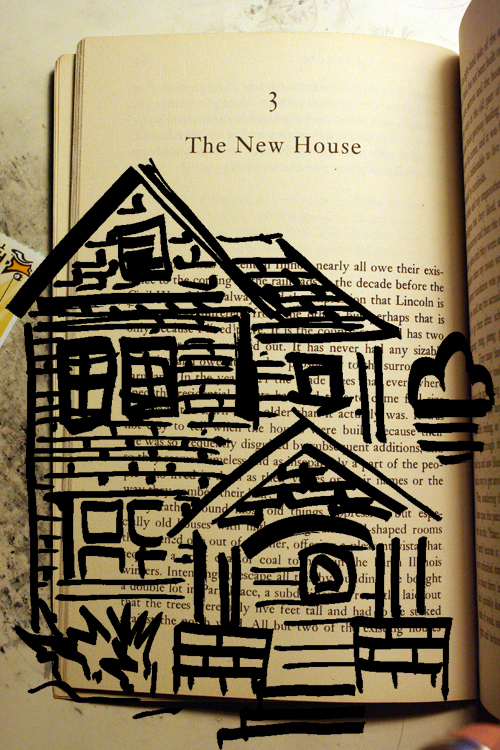In the midst of the mortgage crisis, Meg and I went out and bought a house. We closed today, we move in this weekend. In the five years that we’ve known each other, we’ve never lived in anything bigger than a one-bedroom apartment. Now we both have offices, a washer/dryer, a two-car garage…it’s very surreal.
When you live with someone in a tiny apartment, you’re always in close proximity. You never see that person more than 10 or 20 feet away, because there isn’t 10 or 20 feet to gain between you. You get used to seeing them from a particular distance.
Meg and I often meet each other for lunch on campus. When I see her from far away, walking towards me, she looks like a different person—she looks like a stranger, or someone I just met. It’s like a visual refresh. (I wonder if this visual element isn’t part of the hidden magic of what self-help couples books tell you to do: meet for dinner, but take separate cars…)
I’m reminded of this passage from Dylan Horrocks’ Hicksville:
Maps are of two kinds. Some seek to represent the location of things in space. That is the first kind – the geography of space. But others represent the location of things in time – or perhaps their progression through time. These maps tell stories, which is to say they are the geography of time. […] But these days I have begun to feel that stories, too, are basically concerned with spatial relationships. The proximity of bodies.
I wonder about this proximity of bodies. I wonder how we will grow in a bigger space, with an upstairs and downstairs. How our changing spatial relationships might alter our story…
Above is a sketch of the house, superimposed over a page from William Maxwell’s wonderful short novel, So Long, See You Tomorrow.

hey! neat! congrats
So that’s the big news. Congratulations!
For what space we have in our house, most nights Brian and I seem to wind up on the same end of our couch, drinking beer from the same glass, with the dogs at our feet…
Congratulations! (and know that I’m secretly glad you are now finacially obligated to stay in Austin, Texas :))
Thanks, y’all. We’ll definitely be sticking around ol’ Waterloo for a stretch…
:-D
Congratulations, Austin (and Meg)!
I love this! Your perspective just lovely.
Wishing you all the best in your new home. What a big deal!!!
Man, I keep thinking about your & Horrock’s writings about this. It makes so much sense. So many common spatial phrases come up in relationships:
I need some space.
I feel smothered.
We’re really close.
We’ve grown apart.
I need closure.
Talking down, kissing up, etc.
Keep at arm’s length
Separated (root: pull apart)
Divorced (root: divert, turn away from)
Affinity (root: adjacent, bordering on)
Then there’s a big one: attraction. As in drawing near. Shares roots with “tract” which used to be about a “period or lapse of time” or a “track, course, space, duration”. Or as in a plot of land to share.
Etc. It’s all connected! Congrats.
Indulge me: I found my old senior thesis that had some stuff like this in it…
* * *
IN CHAPTER FOUR of Dylan Horrocks’ graphic novel, Hicksville, a character named Dylan Horrocks and a character named Grace travel to a land named Cornucopia to meet its greatest cartoonist, Emil Kopen. Upon their meeting, Kopen refers to himself not as a comics writer, but as a “cartographer” or a “maker of maps.” This puzzles Horrocks, and prompts Grace to ask Kopen to explain. Kopen says that comics are the same as maps because they are “using all of language—not only words or pictures.” Horrocks asks Kopen about the purpose of maps.
“Maps are of two kinds,” Kopen explains. “Some seek to represent the location of things in space. That is the first kind—the geography of space. But others represent the location of things in time—or perhaps their progression through time. These maps tell stories, which is to say they are the geography of time.”
This monologue is quite similar to Scott McCloud’s argument about comics in Reinventing Comics. He argues that space is the form of comics, and time the content: comics work by mapping time. In Horrocks’ online article “Comics, Games and World-Building” he responds to McCloud’s argument by exploring and expanding the theories of James Kochalka. In Kochalka’s comic, The Horrible Truth About Comics (included in The Cute Manifesto), he proposes an alternative definition of comics to McCloud’s: comics as world-building. “Comics are a way of creating a universe.”
Horrocks interprets:
Even those narratives that would seem to be primarily interested with mapping time, with telling stories, or plots, can be seen in spatial terms. Horrocks’ character Emil Kopen explains to the character Dylan Horrocks that along with maps of geography, he feels that “stories, too, are basically concerned with spatial relationships. The proximity of bodies. Time is simply what interferes with that, yes?”
In Writing Fiction, Janet Burroway writes that while plot has often been seen as a type of “power war” or “back and forth” that seems to be going on between characters, “narrative is also driven by a pattern of connection and disconnection between characters that is the main source of its emotional effect.” Connection and disconnection are spatial terms; they imply different degrees of proximity.